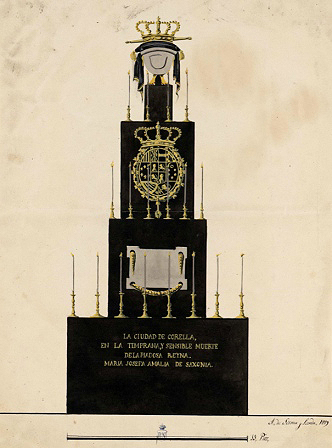The piece of the month of February 2014
THE BURIAL MOUND FOR THE FUNERAL OF MARIA AMALIA OF SAXONY IN CORELLA, 1829
Ricardo Fernández Gracia
Chair of Navarrese Heritage and Art
Among the collection of drawings at the Library Services Nacional in Madrid is that of the catafalque for the funeral honours in Corella for Queen Maria Josefa Amalia of Saxony (DIB/14/47/32). A registration at the foot of the ephemeral monument identifies the place for which it was designed and reads: "LA CIUDAD DE CORELLA, / EN LA TEMPRANA Y SENSIBLE MUERTE / DE LA PIADOSA REYNA / MARIA JOSEFA AMALIA DE SAXONIA". In the lower right-hand margin the artist left a note of authorship: "A. de Sesma y Landa 1829".
It is a drawing on yellowish paper made with pen, brush, ink and black wash and gouache, representing the simple and mournful catafalque at report of the queen, the third of Ferdinand VII's wives, who had died prematurely in the Palace of Aranjuez in May 1829.

Catafalque erected in Corella for the funeral of Maria Amalia of Saxony
Agustín de Sesma y Landa, 1829
(Library Services National)
The author of design , Agustín de Sesma y Landa, was a native of the town of Corella, born in 1803 and died in 1843. He became a lieutenant colonel of artillery and his portrait, painted by Antonio María Esquivel in 1835, is kept in the Arrese collection in Corella, where it came to him through the heir of the military man Fermín Arteta y Sesma, minister of the government. Agustín was the son of Colonel Felipe de Sesma y Payán de Tejada and Doña Teodosia Landa y Orizando. He remained unmarried and died in Pamplona in June 1843, his remains being transferred to Corella in the spring of 1863 to the family pantheon in Corella. His epitaph read as follows:
Nor the roar of the cannon
that he handled with skill
nor the warlike fierceness
nor the century's infection
twisted the heart
nor the singular virtue
of the brave soldier
Don Agustín Sesma y Landa
whom venerable piety
placed in this place

Portrait of Agustín de Sesma y Landa, by Antonio María Esquivel, 1835
Arrese Collection
The tumulus is in keeping with the cold, neoclassical style. It consists of four decreasing bodies lined with black cloth with hardly any decoration of any kind subject, not even the usual skulls or skulls and crossbones. The first body contains the registration to which we have referred reference letter, in the second with eight candlesticks a plaque with a garland, in the third six candlesticks and a large coat of arms with the arms of the deceased and in the fourth behind four candlesticks the urn covered with a red mantle and cushion of the same colour on which appear a large sceptre and the royal crown.
As is well known, this type of architecture, subject , was erected in churches outside the presbytery, usually in the transepts, especially in cities and important towns, centuries ago, for the official celebration of mourning for monarchs, popes and other dignitaries. Without this size and ostentation, they were also erected for other funerals, novenaries and services for the deceased and souls, and even a black cloth on the floor made up for it. The so-called absolution of the catafalque, which consisted of the singing of a solemn dirge for the deceased, was held in front of it. With the entourage of the crucifer, the ceroferarios and acolytes with the censer and the acetre and placed according to the ceremonial that ordered to place the first ones in front of the tomb in front of the altar and the rest with the preste at the other end. After singing the Libera me Domine, the incense was arranged and blessed, the Kyries were sung and the celebrant intoned the Pater noster, which everyone continued in secret. The tomb was then sprinkled with holy water, while the acolyte carrying the cross bowed as the celebrant passed and the accompanying acolytes genuflected. Finally, the incense was incensed and the prayers and the final prayer were intoned, after which everyone retired to the sacristy.
